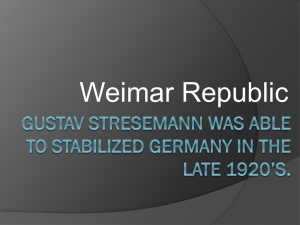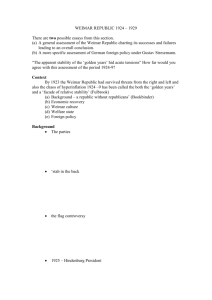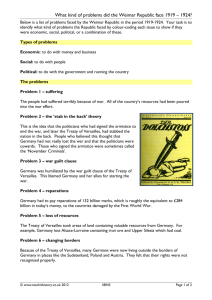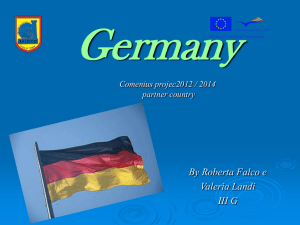Weimar Republic 191-1923
advertisement
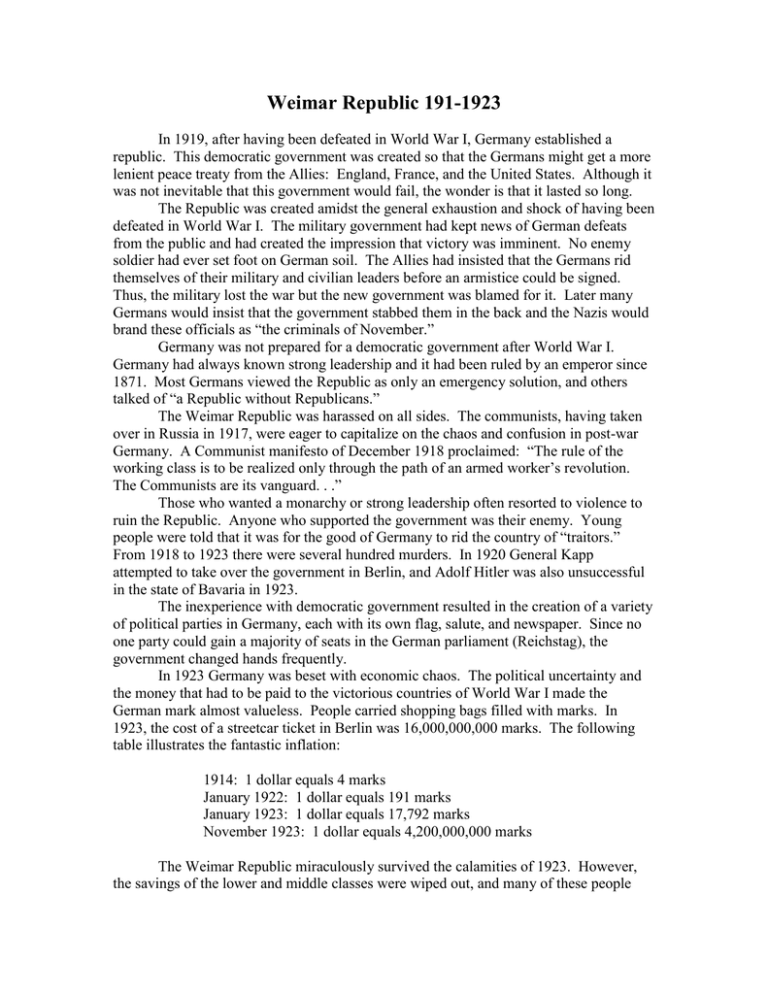
Weimar Republic 191-1923 In 1919, after having been defeated in World War I, Germany established a republic. This democratic government was created so that the Germans might get a more lenient peace treaty from the Allies: England, France, and the United States. Although it was not inevitable that this government would fail, the wonder is that it lasted so long. The Republic was created amidst the general exhaustion and shock of having been defeated in World War I. The military government had kept news of German defeats from the public and had created the impression that victory was imminent. No enemy soldier had ever set foot on German soil. The Allies had insisted that the Germans rid themselves of their military and civilian leaders before an armistice could be signed. Thus, the military lost the war but the new government was blamed for it. Later many Germans would insist that the government stabbed them in the back and the Nazis would brand these officials as “the criminals of November.” Germany was not prepared for a democratic government after World War I. Germany had always known strong leadership and it had been ruled by an emperor since 1871. Most Germans viewed the Republic as only an emergency solution, and others talked of “a Republic without Republicans.” The Weimar Republic was harassed on all sides. The communists, having taken over in Russia in 1917, were eager to capitalize on the chaos and confusion in post-war Germany. A Communist manifesto of December 1918 proclaimed: “The rule of the working class is to be realized only through the path of an armed worker’s revolution. The Communists are its vanguard. . .” Those who wanted a monarchy or strong leadership often resorted to violence to ruin the Republic. Anyone who supported the government was their enemy. Young people were told that it was for the good of Germany to rid the country of “traitors.” From 1918 to 1923 there were several hundred murders. In 1920 General Kapp attempted to take over the government in Berlin, and Adolf Hitler was also unsuccessful in the state of Bavaria in 1923. The inexperience with democratic government resulted in the creation of a variety of political parties in Germany, each with its own flag, salute, and newspaper. Since no one party could gain a majority of seats in the German parliament (Reichstag), the government changed hands frequently. In 1923 Germany was beset with economic chaos. The political uncertainty and the money that had to be paid to the victorious countries of World War I made the German mark almost valueless. People carried shopping bags filled with marks. In 1923, the cost of a streetcar ticket in Berlin was 16,000,000,000 marks. The following table illustrates the fantastic inflation: 1914: 1 dollar equals 4 marks January 1922: 1 dollar equals 191 marks January 1923: 1 dollar equals 17,792 marks November 1923: 1 dollar equals 4,200,000,000 marks The Weimar Republic miraculously survived the calamities of 1923. However, the savings of the lower and middle classes were wiped out, and many of these people became paupers. Since someone had to be blamed, the Republic was the scapegoat. Future governments would be more authoritarian and the ultimate benefactor would be the Nazi party. Germany, 1924-1929 The period from 1924 through 1929 was one of comparative prosperity and calm for Germany. It was a breathing spell for the Republic, both economically and politically. Germany and the world calmed down and there was an upward trend in the economy. The economic recovery of Germany has been called “one of the most spectacular recoveries in the world’s entire economic history.” Germany borrowed a great deal of money, particularly from the United States. In addition, the Germans copied many successful American business practices, such as standardization of parts, improved business organization, and the concentration of industries for purposes of efficiency. American influence was strongest from companies such as Ford, Chrysler, General Motors, and Eastman Kodak. Germany became the most powerful industrial country in Europe and the most modern country on the continent. The German automobile industry became the largest in Europe. Germany was very productive in such industries as coal, steel, chemicals, and electrical supplies. The Weimar Republic was given further credibility when Paul von Hindenburg, Chief of Staff of the German army in World War, became president in 1925. Since the civilian government and not the military leaders signed both the Armistice and the Treaty of Versailles, Hindenburg was still seen as a war hero. Hindenburg was eighty, a believer in monarchy, and an outspoken opponent of the Weimar Republic. He did, however, operate within the limits of the constitution. He was a national institution, the image of a strong figure for the Republic. However, the key figure in the period 1924-1929 was Gustav Stresemann, the German foreign minister. Like Hindenburg, he was a monarchist. In spite of this Stresemann took a common sense approach toward Germany’s problems. Stresemann wanted to build good will with other countries, despite the fact that this meant cooperating with those who had defeated Germany in World War I. Stresemann’s chief goals were to lower the reparations payments that Germany was forced to pay to the Allies (33,000,000,000 dollars) and to gain German entrance into the League of Nations. The League was an association of countries that was a forerunner to the United Nations. In 1925 Germany began a period of improved relations with France by signing the Locarno Pact. In this treaty, France, Belgium, and Germany agreed to respect each other’s boundaries. The countries further agreed “in no case to go to war against each other.” In 1926 Germany was admitted to the League of Nations. The League was the brain child of President Wilson of the United States, who saw the agency as a means of preventing future wars. Stresemann viewed German entrance as providing an opportunity for Germany to state its case to the world and to work for changes in the Treaty of Versailles. For his work in promoting international good will, Stresemann was awarded the Nobel Peace Prize in 1927. In 1929 Germany signed the Kellogg-Briand Peace Pact, which “outlawed wars as an instrument of national policy” and limited its use to defensive purposes only. Many leaders had the feeling that the world was in for a long period of peace. Stresemann also made progress for Germany in the matter of reparations payments to the allies. In 1924 the Dawes Plan scaled down the amount of money Germany had to pay annually. In 1929 the Young Plan reduced the total amount of the reparations bill to 28,000,000,000 dollars and spread the payments out over 59 years. Stresemann had accomplished much by attempting what was possible. Many problems still confronted Germany; the country was borrowing large sums of money, all Germans hated the Treaty of Versailles and Germany was very much dependent on what happened economically and politically in the rest of the world. Nonetheless, this period of calm and prosperity serves to remind us that what happened in Germany later was not inevitable.
